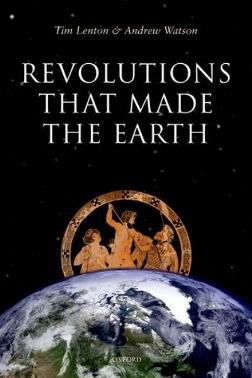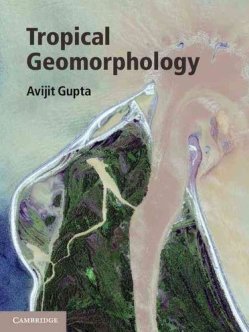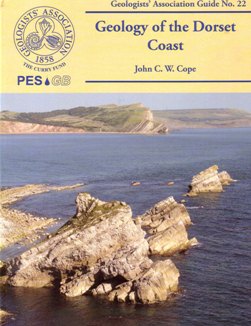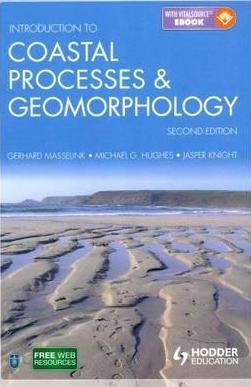 Revolutions That Made The Earth
Revolutions That Made The Earth
This book is a ‘MUST’ read! It tells the strange and fascinating story of the entangled histories of life and the planet, from the perspective that a very few profound revolutions have made the Earth as we know it. Most of these revolutions happened in the Precambrian, but we are now living through a new one by transforming the planet ourselves.
Each of these revolutions is a transformation of the entire system of life, coupled to the planetary environment. Together, that life and its environment comprise the ‘Earth System’ - the many processes that interact to set living conditions, and to sustain life – which we can only fully understand by studying all its parts as a whole; so not surprisingly the book ranges through fields as disparate as astronomy, geology, geochemistry and biology. The key to understanding how this system works is understanding positive and negative feedbacks.
Following the Introduction in Part I, the book moves to Theory in Part II, exploring the properties of an Earth system dominated by feedbacks. Part III focuses on the first great transformation of the Earth system by the development of the creators of oxygen and its abrupt accumulation in the atmosphere. Part IV tackles the transformation that started with the evolution of a new type of cell and ended with the appearance of complex creatures in the Cambrian explosion of life. Part V deals with the history of the planet from the Cambrian to the present, illuminating it through the laser beam of Earth System science and exploring how feedback processes conspired to make that history what it is.
Finally, Part VI examines how unrestrained economic growth and our undervaluing of the environment are polluting the planet by dumping greenhouse gases into the atmosphere and unused nutrients into the ocean. This Human Revolution is creating a ‘Tragedy of the Commons’ through unregulated use of resources held in common, leading inexorably to the disbenefit of all.
Despite the appeals of environmentalists, business is proceeding much as usual. Can we sustain the increasing use of energy by an increasing population? Lenton and Watson do not share the apocalyptic vision of their mentor James Lovelock. We can use more energy, provided we put in the massive efforts required to minimise the use of coal, gas and oil; to maximise the use of dense energy sources like the sun, nuclear fission and, ultimately, nuclear fusion; to extract carbon dioxide from the air; and to minimise waste by recycling everything. Just as in the banking industry, economic activity must be balanced by regulation – as pointed out long ago by Adam Smith in the ‘Wealth of Nations’.
Reviewed by Colin Summerhayes
REVOLUTIONS THAT MADE THE EARTH.
TIM LENTON & ANDREW WATSON. Published by Oxford University Press, 2011. ISBN 978-0-19-958704-9. 440 pp. List price £29.95. www.oup.co.uk.
 Tropical Geomorphology
Tropical Geomorphology
Tropic Geomorphology is an immense subject, but well covered by this book. Many of the basic processes will be familiar to British geologists, but with an interesting tropical twist. Geomorphic processes operating in the tropics do so at different rates and intensities compared with elsewhere. Weathering, erosion, slopes and hydrology are also considered.
The book describes both the humid and arid tropics. It is up to date and talks of the use of geomorphology in the management and sustainable development of the tropics. It talks of geology, landforms and processes and the movement of water and sediments from the mountains (some of which include glaciers) to the sea.
The author looks at weathering in detail, considering both its effects on rocks and minerals. It looks at rivers in the tropics some of which are very large (e.g. the Amazon) and alluvial valleys, deltas and coasts. The author also looks at particular land types, including volcanic and karstic landscapes. Among other things, precipitation, wind circulation and temperature are described, as are tropical disturbances such as cyclones, and the effects of tropical vegetation.
The author reviews the Quaternary rocks found in the tropics briefly, and considers how the ice ages affected them. He then focuses on anthropogenic effects on geomorphic processes and urban geomorphology (giving examples of geomorphic hazards and their amelioration in Singapore, Kingston and Bangkok). He then moves on to consider human effects on processes including, of course, climate change.
The geomorphology of the future will reflect three factors; the normal pattern of landform and processes, their anthropogenic modification, and the effect of climate change - particularly on rainfall and tropical cyclone activity. At the very end of the book Gupta acknowledges that the combined effects of these three are difficult to determine in any particular location, or across a large geomorphic system.
In summary, this book is well-written, in an interesting and easy-to-read style. It is a hardback, well printed and solidly bound, with many informative diagrams, excellent plates and useful satellite images. Sets of questions mark the end of each chapter, which will encourage readers to explore the subject further. It is suitable as an advanced undergraduate textbook, or as a handy reference for someone practising geomorphology in tropical regions and constitutes excellent value at £45.
Reviewed by Steve Rowlatt
TROPICAL GEOMORPHOLOGY
AVIJIT GUPTA Published by: Cambridge University Press. 2011 ISBN: 978-0-521-87990-3 Hardback. 386pp www.cambridge.org List price: £45
 GEOLOGY OF THE DORSET COAST
GEOLOGY OF THE DORSET COAST
I have often wondered what the Geologists Association – of which I am a proud member – means by its occasional strapline ‘The True Spirit of Geology’; but after reading this excellent addition to its suite of Guides, I think I know. Tip O’Neill once famously said ‘All politics is local’, and if that is true, then all history is local, and from that it follows that all geology is, or ought to be, local too. But local geology is not just for local people, because ‘local’ is not the same as ‘parochial’. The ‘true spirit’ lies in the fact that your local geology is as important as anyone else’s; because from the local, you can glimpse the global - and that is where the joy of geology, for me, always lay.
In revising the previous edition by Michael House, the author was following a tough act; but even the best guides date, and arguably nobody knows the geology of Dorset better than John Cope. His approach is rigorous and structured, beginning with a concise summary of the succession, including unexposed rocks; an analysis of the County’s surprisingly complex structure, and a special section on the habitat of oil. Then follow three classic excursions covering West, South and East Dorset/Purbeck. There is a copious reference list and index.
The handbook is produced in the series’ now standard spiral binding with soft cover, which is highly practical, allowing the book to lie flat or to be folded back on itself without damage. Production values are high, with lovely colour maps, sections and excellent photographs. The author’s experience as the leader of countless Dorset field excursions is everywhere evident, with up-to-date and practical guidance on footpaths, lunch spots and access to beaches and quarries.
For a practical field guide, 232 pages is probably the upper limit; which perhaps explains why space could not be found for seismic sections, which can be so helpful in explaining deep structure, or diachronism in the Bridport Sands for example. But there is always more to say, and Cope is to be commended all the more for not neglecting other subjects of interest to visitors, such as Thomas Hardy, T E Lawrence, or the archaeology of Maiden Castle. (Though referring to Sir Thomas Masterman Hardy, 1st Baronet, Captain of the Victory at Trafalgar, later First Naval Lord at the Admiralty and Vice-Admiral of the Blue as “Nelson’s henchman” seemed, even to me, to take journalistic shorthand a little far!)
Reviewed by Ted Nield
THE GEOLOGY OF THE DORSET COAST
JOHN C W COPE. GA Guide #22. Published by: Geologists’ Association 2012 ISBN: 9780900717611, 232pp List Price: £14.00 (Members £11.00) www.geologistsassociation.org.uk/GAGuideSales.html
 Introduction to Coastal Processes & Geomorphology (2nd Edition)
Introduction to Coastal Processes & Geomorphology (2nd Edition)
The new edition of this book provides comprehensive coverage of undergraduate-level coastal themes. This well structured paperback, also available as an e-book, uses numerous black and white diagrams and images that are based on international and UK-based case studies, giving the reader a wide experience of coastal geomorphological features.
Focused on physical processes, the book is an excellent guide to natural coastal dynamics, particularly tides and waves, sediment movement, tide- and wave-dominated coasts, geologically-controlled coasts and the climate-coast relationship. The new climate-oriented chapters venture into the human impacts of coastal and sea level change, leaving the reader wanting to research deeper into the subject. For example, the Intergovernmental Panel on Climate Change (IPCC) 2007 projections and the regional UK Climate Impact Programme 2009 probabilistic projections of climate change are introduced, but more information could have been provided about projection outputs and potential impact.
Although the book is aimed primarily at undergraduates, there are elements that challenge the reader and promote the development of critical, academic thought. In this respect the book is very accessible and provides a solid baseline for advanced lines of enquiry. The references have been partially updated since the release of the First Edition in 2003, and include a number of essential handbooks; but there was perhaps scope for more updating in the very dynamic areas of climate change and sea level research.
Undergraduates who read this book will benefit from the reflective questions that are posed at the end of each chapter. These excellent revision aids are coupled with the online materials; extended case studies, worked examples, multiple choice questions and MP3 format answers to the reflective questions. All online resources are free to book-holders.
Some aspects would have benefited from a little more care and attention to updating. For example the isostatic maps of the UK presented are based on a 23 year-old paper, rather than on more recent studies such as the 2009 models produced by scientists at the University of Durham. Some of the case studies could have been developed further. For example, the Porthcawl (South Wales) case study ends in the early 1980s and shortly after this the foreshore at the foot of the seawall was covered in an asphalt-concrete layer with a bitumen-grouted toe. The authors’ opinions on this effective, but unsightly, coastal defence method would have been enlightening.
The coastal processes and geomorphology explanations are timeless, extremely well-presented and accompanied by excellent case studies. This edition includes new and insightful materials, including discussion of several new coastal valuation initiatives, such as Fuzzy Logic Scenic Evaluation. All in all, this book is essential reading for any GEES-discipline undergraduate student interested in coastal processes and their management.
Reviewed by Victoria Powell
INTRODUCTION TO COASTAL PROCESSES & GEOMORPHOLOGY (2nd Edition)
GERHARD MASSELINK, MICHAEL G HUGHES AND JASPER KNIGHT. Published by: Hodder Education, 2011 ISBN: 978-1-444-122-404. 432 pp www.hoddereducation.com List price: £34.99